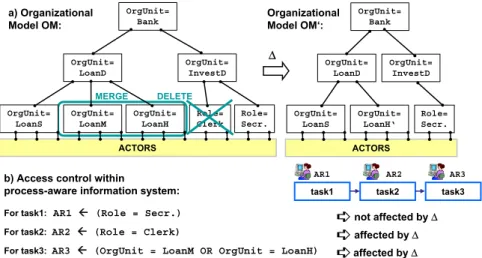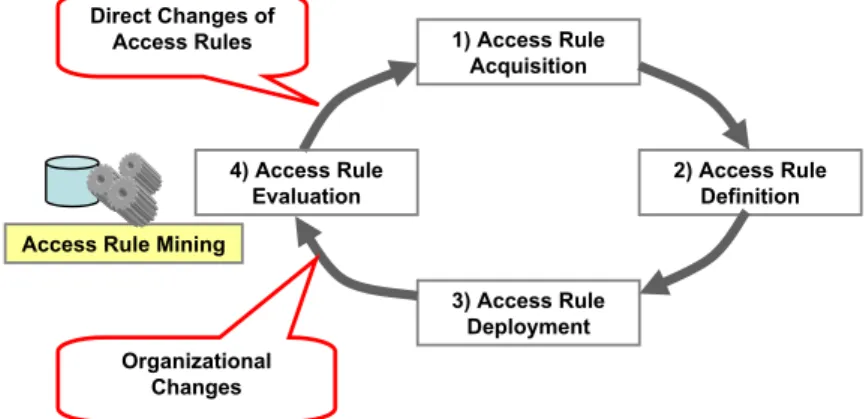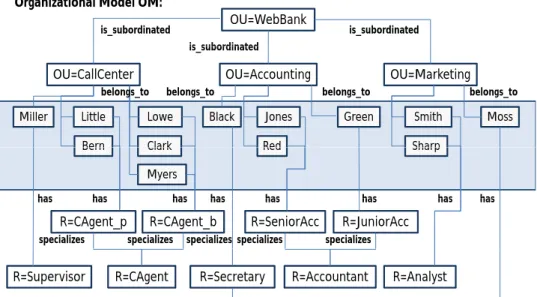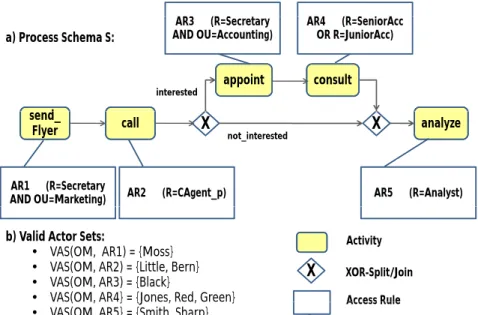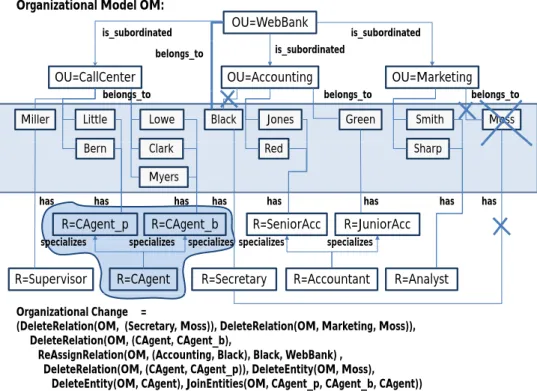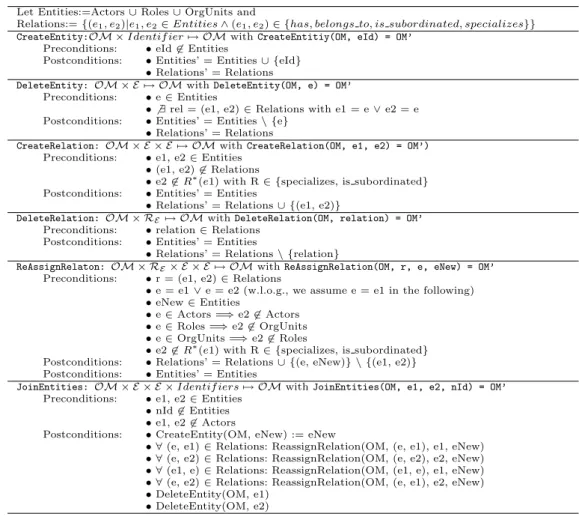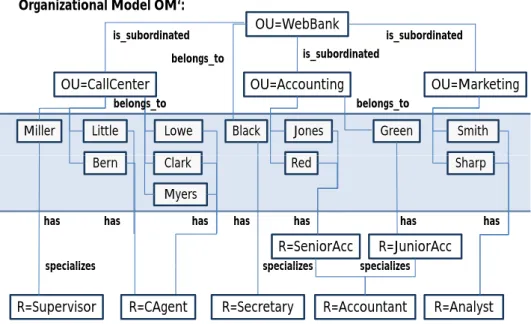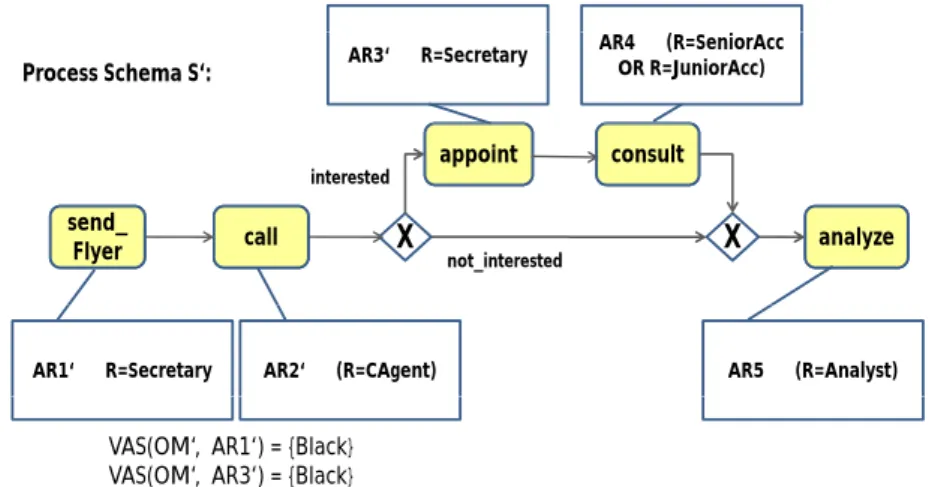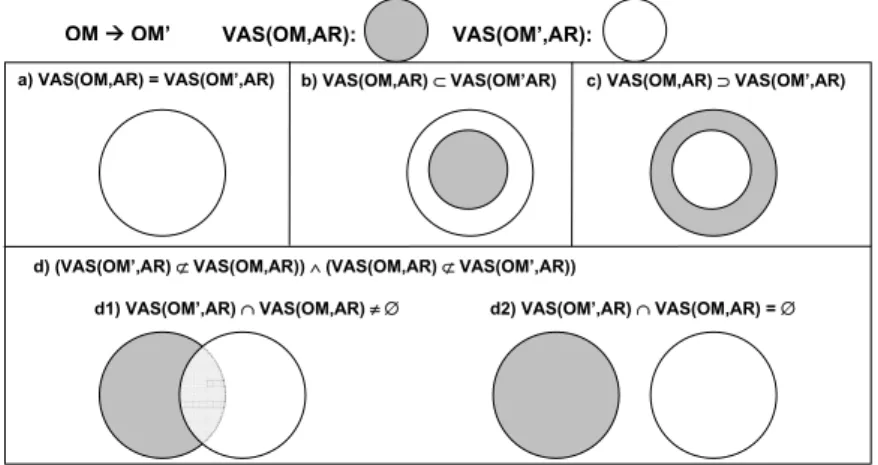Enterprise Information Systems Vol. 00, No. 00, February 2009, 1–30
RESEARCH ARTICLE
Comprehensive Life Cycle Support for Access Rules in Information Systems: The CEOSIS Project
Stefanie Rinderle-Ma and Manfred Reichert
Institute of Databases and Information Systems, Ulm University, Ulm, Germany {stefanie.rinderle, manfred.reichert}@uni-ulm.de
(Received 00 Month 200x; final version received 00 Month 200x) The definition and management of access rules (e.g., to control access to busi- ness documents and business functions) is a fundamental task in any enterprise information system (EIS). While there exists considerable work on how to spec- ify and represent access rules, only little research has been spent on access rule changes. Examples include the evolution of organizational models with need for subsequent adaptation of related access rules as well as direct access rule modifications (e.g., to state a previously defined rule more precisely). This pa- per presents a comprehensive change framework for the controlled evolution of role-based access rules in EIS. First, we consider changes of organizational models and elaborate how they affect existing access rules. Second, we define change operations which enable direct adaptations of access rules. In the latter context, we define the formal semantics of access rule changes based on opera- tor trees. Particularly, this enables their unambiguous application; i.e., we can precisely determine which effects are caused by respective rule changes. This is important, for example, to be able to efficiently and correctly adapt user work- lists in process-aware information systems. Altogether this paper contributes to comprehensive life cycle support for access rules in (adaptive) EIS.
Keywords:Enterprise Information System, Change, Access Control, Access Rule Lifecycle
1. Introduction
A fundamental aspect in the design of any enterprise information system (EIS) concerns access control, i.e., granting certain rights to specific users (e.g., the right to access a certain business document for a restricted group of users). There exists a multitude of models for defining access control mechanisms; e.g., GRANT / REVOKE statements in Database Management Systems or Role Based Access Control (RBAC) in process-aware information systems (PAIS). Usually such models comprise a set of access rules which are defined based on an organizational model capturing organizational entities as well as their relationships. Access rules then control which rights shall be granted to which users.
In the context of PAIS, for example, access rules specify which tasks shall be offered as work itemsto which users in their worklists during the execution of a particular process
ISSN: 1751-7575 print/ISSN 1751-7583 online c 2009 Taylor & Francis
DOI: 10.1080/1751757YYxxxxxxxx http://www.informaworld.com
instance.
1.1. Problem statement
Due to changes of organizational structures or evolving security policies, access rules have to be frequently adapted. This, in turn, must be effectively handled by the EIS in order to be able to cope with these organizational or policy changes in a quick, flexible, and secure way. So far, only little research has been spent on the evolution of access rules and the resulting effects on the underlying EIS. In particular, access rules might be subject to the following kinds of changes:
• Organizational Change:Access rule adaptations often become necessary when changing an organization and its organizational model respectively. For instance, assume that access control within a PAIS (i.e., the assignment of work items to user worklists) is based on the simple access rules depicted in Fig. 1. Assume further that these rules are based on organizational model OM. To streamline the organization, units LoanM and LoanHare merged into organizational unitLoanH’, and roleClerkis deleted from OM resulting in organizational model OM’. Obviously, access rule AR1 is not affected by this organizational change, whereas access rules AR2 and AR3 now refer to entities no longer being present in OM’. If the affected access rules were not adapted this would threaten robustness or security constraints of the PAIS. Worst case, for access rules which cannot be resolved properly, the associated task is offered to unauthorized users (e.g., process administrators, actors of preceding tasks, and so forth).
b) Access control within
process-aware information system:
For task1: AR1 Å (Role = Secr.) For task2: AR2 Å (Role = Clerk)
For task3: AR3 Å (OrgUnit = LoanM OR OrgUnit = LoanH) MERGE
OrgUnit=
Bank
OrgUnit=
LoanD
OrgUnit=
InvestD
OrgUnit=
LoanS
OrgUnit=
LoanM
OrgUnit=
LoanH
Role=
Clerk Role=
Secr.
ACTORS a) Organizational
Model OM:
Δ
OrgUnit=
Bank
OrgUnit=
LoanD
OrgUnit=
InvestD
OrgUnit=
LoanS
OrgUnit=
LoanH‘
Role=
Secr.
ACTORS Organizational Model OM‘:
¹not affected byΔ
¹affected byΔ
¹affected byΔ DELETE
task1 task2 task3
AR1 AR2 AR3
Figure 1. Organizational changes affecting access rules
• Direct Access Rule Changes:Generally, it must be also possible to directly adapt access rules within EIS (cf. Fig. 2). This will become necessary, for example, if access rules are not specified precisely enough. Either the access rule covers a too broad range of users (i.e., only a subset of the users qualifying for the access rules actually work on the associated work items) or it is too narrow (e.g., the related task is always delegated to substitutes). In both cases, the specified access rules do not reflect the real situation.
As a consequence, task assignment is handled outside the system and thus might be not properly documented. Furthermore, manual task assignment or adaptation can be complex, time-consuming and error-prone.
1) Access Rule Acquisition
2) Access Rule Definition
3) Access Rule Deployment 4) Access Rule
Evaluation Direct Changes of
Access Rules
Organizational Changes Access Rule Mining
Figure 2. Access rule life cycle
1.2. Contribution
In this paper we present our CEOSIS1 framework for evolving access rules within EIS in a controlled and secure way. We first consider changes of organizational models and evaluate how they affect existing access rules. Then we cope with issues related to direct changes of access rules. As discussed in Section 1.1 both scenarios are highly relevant in practice and should therefore be adequately supported by an EIS.
There are two basic requirements for changes of access rules in EIS. First of all, they must be conducted in acorrectway; i.e., they must not violate any structural constraints set out by the formalism for access rule specification. To fulfill this requirement we base the definition of access rule changes on an operator tree representation and equip respective operators with formal pre- and post-conditions which ensure their correct application. Second, theformal semanticsof access rule changes must be specified. Only this guarantees their unambigous application and supports the precise analysis of change effects. To achieve this, we base the semantics of access rule changes on the effects they have on associatedvalid actor sets; i.e., the set of actors who qualify for the particular access rule. This also enables, for example, analysis of access rule change effects on user worklists in PAIS.
Note that this paper significantly extends the work we presented in Rinderle-Ma and Reichert (2008). Besides giving more technical details and additional examples, we com- plement our results on the change of access rules by a comprehensive discussion on the controlled evolution of organizational models and their effects on access rules. Completely new conceptual results are provided with respect to the support of high-level change op- erations on access rules. Here, the interesting conclusion is that based on additional knowledge from the associated organizational model the semantics of such high-level operations can be determined without recalculating valid actor sets from scratch.
The remainder of this paper is organized as follows: Section 2 provides fundamentals on organizational models and corresponding access rules. Based on this, Section 3 deals with changes of organizational models and discusses how they might affect related access rules. Following this, we deal with direct access rule changes in EIS. Section 4 provides well-defined change operations for this and Section 5 defines their formal semantics. We extend this work in Section 6 by showing how to exploit organizational knowledge for enabling high-level access rule changes. Section 7 discusses our approach and Section 8 deals with related work. We close with a summary and outlook in Section 9.
1CEOSIS: Controlled Evolution of Organizational Structures in Information Systems
2. Organizational models and access rules
In this section we provide information needed for the formal underpinning of our work.
2.1. Organizational models
An organizational meta model defines entity and relation types based on which con- crete organizational structures can be modeled; i.e., the meta model can be seen as the schema which can be instantiated multiple times by concreteorganizational models. The organizational meta model OMM used in this paper is based on theRole Based Access Control Model (RBAC) as described in Ferraiolo et al. (2003). Basically, it consists of entity typesOrganizationalUnit,Actor, andRole(cf. Fig. 3). Concrete organizational units (e.g., clinic) can be hierarchically related to each other based on relation type is subordinated. Similarly, concrete roles can be specialized by introducing correspond- ing sub roles (relation typespecializes). Thereby, a sub role inherits all abilities of its superior role, but may have additional ones. Finally, actors may have roles (relation type has) and belong to organizational units (relation type belongs to).
specializes
is subordinated specializes
belongs to has is_subordinated
(0,n) (0,1) (0,1) (0,n)
OrganizationalUnit Actor Role
belongs_to has
( , ) ( , )
(0,n) (0,1) (0,n) (0,n)
(0,1) (0,n)
Figure 3. Organizational meta model (in ER notation)
We use this well-established, but rather simple organizational meta model OMM in this paper in order to focus on core issues related to access rule changes. However, subse- quent considerations can be transferred to more complex organizational meta models as well; e.g., capturing entities such as abilities or substitution relations (see Rinderle and Reichert (2007) for examples).
Based on OMM, concrete organizational models can be defined; i.e., a concrete or- ganizational model OM constitutes an instance of OMM (cf. Def. 2.1). Consider the example shown in Fig. 4. The depicted organizational model OM comprises the three organizational units (OU) CallCenter, Accounting and Marketing, which are hierar- chically subordinated to organizational unitWebBank. RoleCAgent, in turn, is specialized by rolesCAgent pand CAgent b. Finally, actors are assigned to roles and belong to one organizational unit (e.g., actorBlack has roleSecretary and belongs to organizational unitAccounting).
Definition 2.1 : Organizational model. An organizational model is a tuple OM = (Actors, Roles, OrgUnits, has, belongs to, is subordinated, specializes), where:
• Actors corresponds to the set of actors; i.e., the people performing activities or access- ing data objects,
• Roles corresponds to the set of organizational roles,
• OrgUnits corresponds to the set of organizational units,
• has ⊆ Roles ×Actors captures the relations linking actors to roles,
OU=WebBank Organizational Model OM:
is_subordinated is_subordinated
is subordinated
OU=CallCenter OU=Accounting OU=Marketing
is_subordinated
belongs_to
belongs_to belongs_to belongs_to
Miller Little Bern
Black Green
Sharp
Moss Jones
Clark
Smith Red
Lowe g _
g _ g _ g _
Bern Clark Sharp
Myers
Red
has has has
has has has has has
R=JuniorAcc R=CAgent_p R=CAgent_b R=SeniorAcc
has has has
has has has has has
specializes specializes specializes specializes specializes
R=Supervisor R=CAgent R=Secretary R=Accountant R=Analyst
Figure 4. Organizational model for online banking scenario
• belongs to⊆ OrgUnits×Actors captures the relations linking actors to organizational units,
• is subordinated ⊆OrgUnits ×OrgUnits defines the organizational hierarchy, and
• specializes ⊆Roles × Roles defines the role hierarchy.
Furthermore, two notions on relations are needed in the following:
- R(x) :={y∈X|(x,y)∈R}for any relation R∈ {has, belongs to, specializes, is subordinated}
- R∗ is the transitive closure of R
Consider Fig. 4. An example for generic relation R(x) is given by has(Secretary) = {Black, Moss} (with R = ’has’). The semantics of the two relations is subordinated and specializes can be informally defined as follows: All actors belonging to an orga- nizational unit also belong to its superordinated organizational units; e.g., actorsSmith, SharpandMoss, who all belong to organizational unitMarketing, also belong to superor- dinated organizational unitWebBank(cf. Fig. 4). Furthermore, if an actor has a particular role she will possess all superior roles as well; e.g., actorJoneshas role SeniorAcc and therefore also posesses roleAccountant.
2.2. Access rules
We provide a notion for access rules and specify their formal semantics. We need this information later in order to be able to reason about access rule changes.
Definition 2.2 : Elementary access rule. Let OM = (Actors, ...) be an organiza- tional model (cf. Def. 2.1). An elementary access rule EAR on OM is defined as follows:
EAR ≡ (EAR0 ←− τ∗)1 | (EAR1 ←− Role =r) | (EAR2 ←− OrgUnit = o) | (EAR3 ←− Role+ = r)| (EAR4 ←− OrgUnit+ = o).
The set of all entities qualifying for an elementary access ruleEAR onOM can be defined as follows:
QualEntities(OM,EAR) =
r : EAR=EAR1
o : EAR=EAR2
specializes∗(r) : EAR=EAR3 is subordinated∗(o) : EAR=EAR4
∅ : otherwise
Formal semantics of elementary access rule EAR is defined over the set of valid actors qualifying for EAR based on OM. We denote this set as VAS(OM, EAR)⊆ Actors with
• VAS(OM, EAR0) = ∅
• VAS(OM, EAR1) = has(r), i.e., the set of actors having role r.
• VAS(OM, EAR2) = belongs to(o), i.e., the set of actors belonging to unit o.
• VAS(OM, EAR3) = has(specializes∗(r)); i.e., the set of actors having role r or a more specialized one.
• VAS(OM, EAR4) = has(is subordinated∗(o)); i.e., the set of actors belonging to orga- nizational unit o or a subordinated one.
Fig. 5 gives an example for the use of access rules in a PAIS. It shows a simple business process model representing a direct marketing measurement in an online banking sce- nario. For each process activity, its associated access rule specifies which actors qualify for carrying out this activity based on organizational model OM (cf. Fig. 4). First of all, a flyer on a new product is sent to private customers by the secretary of the marketing unit. Then, these customers are contacted by a call agent who is specialized on private customers. If a customer shows interest, an appointment for another consulting will be made by the secretary of the accounting unit. This consulting is subsequently done by a senior or junior accountant. Finally, the outcome of the marketing measurement is evaluated by an analyst.
Specifically, Fig. 5 shows two elementary access rules AR2and AR5 and the associated valid actor sets based on organizational model OM. Taking elementary access rules as basis, the general notion of access rule can be formally defined (see below). Here, ele- mentary access rules may be combined by logical operators AND, OR, and NOT. Note that we restrict the complexity of access rules by using negation only in the context of elementary access rules. However, this constitutes no restriction regarding the expres- siveness of access rules since any negation contained within an access rule AR can be always pushed to the elementary access rules contained within AR.
Definition 2.3 : Access rule.Let OM be an organizational model. An access rule AR is defined as concatenation of other access rules by using logical operators AND, OR, and NOT. Formally:
1τ∗denotes an empty term.
a) Process Schema S:
AR3 Å(R=Secretary AND OU=Accounting)
AR4 Å(R=SeniorAcc OR R=JuniorAcc)
d
appoint consult
interested
send_
Flyer call X X analyze
not_interested
AR1 Å(R=Secretary
AND OU=Marketing) AR2 Å(R=CAgent_p) AR5 Å(R=Analyst)
b) Valid Actor Sets:
• VAS(OM AR1) = {Moss}VAS(OM, AR1) {Moss} Activity
• VAS(OM, AR2) = {Little, Bern}
• VAS(OM, AR3) = {Black}
• VAS(OM, AR4} = {Jones, Red, Green}
X XOR-Split/Join Access Rule VAS(OM, AR4} {Jones, Red, Green}
• VAS(OM, AR5} = {Smith, Sharp}
Access Rule
Figure 5. Direct marketing process (in BPMN notation)
AR ≡ EAR |NEAR |CAR |DAR where
• EAR constitutes an elementary access rule (cf. Def. 2.2),
• NEAR ←− (NOT (EAR)) where EAR is an elementary access rule,
• CAR ←− (AR1 AND AR2) where AR1 and AR2 are access rules, and
• DAR ←− (AR1 OR AR2) where AR1 and AR2 are access rules.
Formal semantics of elementary access rule EAR has been already given in Def. 2.2, the one of NEAR, CAR and DAR can be defined as follows:
• VAS(OM,NEAR) = Actors\ VAS(OM,AR) corresponds to the set of actors not qual- ifying for access rule AR,
• VAS(OM,CAR) = VAS(OM,AR1) ∩ VAS(OM,AR2) corresponds to the set of actors qualifying for access rules AR1 and AR2,
• VAS(OM,DAR) = VAS(OM,AR1) ∪ VAS(OM,AR2) corresponds to the set of actors qualifying for access rules AR1 or AR2
AROM denotes the set of all access rules over OM.
Fig. 5 depicts non-elementary access rulesAR1,AR3, andAR4. RegardingAR1, for exam- ple, valid actor setVAS(OM, AR1)corresponds to intersection ofVAS(OM, R=Secretary)
={Black,Moss}and VAS(OM, OU=Marketing) ={Smith,Sharp,Moss}.
3. Organizational changes and their effects on access rules
In this section we present a framework for modifying organizational models while con- trolling the effects on access rules at the same time.
3.1. On changing organizational models
Assume that our online bank has to streamline its organization due to a financial crisis (cf.
Fig. 4 and Fig. 5). Necessary actions are depicted in Fig. 6. Due to the reorganization, there is no longer a distinction between call agents serving private customers and those dealing with business customers; i.e., these two roles are now merged into roleCAgent.
Furthermore, only one secretary for the wholeWebBankremains; i.e., one secretary is laid off and roleSecretary is reassigned to organizational unitWebBank. The challenge now is to realize these changes for the given organizational model, which is implemented and used by one or more EIS.
OU=WebBank Organizational Model OM:
is_subordinated is_subordinated
OU=CallCenter OU=Accounting OU=Marketing
is_subordinated
b l b l b l
belongs_to
Miller Little Lowe Black Jones Green Smith Moss
belongs_to belongs_to belongs_to
Bern Clark Sharp
Myers
Red
R=JuniorAcc R=CAgent_p R=CAgent_b R=SeniorAcc
has has has
has has has has has
specializes specializes specializes specializes specializes
R=Supervisor R=CAgent R=Secretary R=Accountant R=Analyst
specializes specializes specializes specializes specializes
Organizational Change Δ=
(DeleteRelation(OM, (Secretary, Moss)), DeleteRelation(OM, Marketing, Moss)), DeleteRelation(OM, (CAgent, CAgent b),
DeleteRelation(OM, (CAgent, CAgent_b),
ReAssignRelation(OM, (Accounting, Black), Black, WebBank) , DeleteRelation(OM, (CAgent, CAgent_p)), DeleteEntity(OM, Moss),
DeleteEntity(OM, CAgent), JoinEntities(OM, CAgent_p, CAgent_b, CAgent)) Figure 6. Changes after streamlining the organization
In order to be able to express all relevant kinds of changes of an organizational model OM, CEOSIS provides a complete set of basic change operations1 with well defined semantics; e.g., for creating or deleting organizational entities as well as the relations be- tween them. For each change operation there are formal pre- and postconditions, which enables preservation of the correctness properties of organizational modelOM when ap- plying the operation(s) to it (assuming thatOM was a correct model before). In addition to these basic change operations, CEOSIS provides common high-level operations in or- der to facilitate change definition and to capture more semantics about model changes.
As example of such a high-level operation consider the join of two entities (e.g., a fusion of two organizational units as depicted in Fig. 6). Table 1 depicts selected basic as well as high-level operations for changing organizational models in CEOSIS.
At the bottom of Fig. 6 the change operations needed to realize the desired streamlin- ing actions (i.e., adaptations of the given organizational model of our running example)
1Completeness means that a given organizational modelOM can be applied to an arbitrary other organizational modelOM0using the given set of change operations.
Table 1. Selection of change operations on organizational models (Rinderle and Reichert (2007))
Let Entities:=Actors∪Roles∪OrgUnits and
Relations:={(e1, e2)|e1, e2∈Entities∧(e1, e2)∈ {has, belongs to, is subordinated, specializes}}
CreateEntity:OM ×Identif ier7→ OMwithCreateEntitiy(OM, eId) = OM’
Preconditions: •eId6∈Entities
Postconditions: •Entities’ = Entities∪ {eId}
•Relations’ = Relations
DeleteEntity: OM × E 7→ OMwithDeleteEntity(OM, e) = OM’
Preconditions: •e∈Entities
• 6 ∃rel = (e1, e2)∈Relations with e1 = e∨e2 = e Postconditions: •Entities’ = Entities\ {e}
•Relations’ = Relations
CreateRelation: OM × E × E 7→ OMwithCreateRelation(OM, e1, e2) = OM’) Preconditions: •e1, e2∈Entities
•(e1, e2)6∈Relations
•e26∈R∗(e1) with R∈ {specializes, is subordinated}
Postconditions: •Entities’ = Entities
•Relations’ = Relations∪ {(e1, e2)}
DeleteRelation: OM × RE7→ OMwithDeleteRelation(OM, relation) = OM’
Preconditions: •relation∈Relations Postconditions: •Entities’ = Entities
•Relations’ = Relations\ {relation}
ReAssignRelaton: OM × RE× E × E 7→ OMwithReAssignRelation(OM, r, e, eNew) = OM’
Preconditions: •r = (e1, e2)∈Relations
•e = e1∨e = e2 (w.l.o.g., we assume e = e1 in the following)
•eNew∈Entities
•e∈Actors =⇒e26∈Actors
•e∈Roles =⇒e26∈OrgUnits
•e∈OrgUnits =⇒e26∈Roles
•e26∈R∗(e1) with R∈ {specializes, is subordinated}
Postconditions: •Relations’ = Relations∪ {(e, eNew)} \ {(e1, e2)}
Postconditions: •Entities’ = Entities
JoinEntities: OM × E × E ×Identif iers7→ OMwithJoinEntities(OM, e1, e2, nId) = OM’
Preconditions: •e1, e2∈Entities
•nId6∈Entities
•e1, e26∈Actors
Postconditions: •CreateEntity(OM, eNew) := eNew
• ∀(e, e1)∈Relations: ReassignRelation(OM, (e, e1), e1, eNew)
• ∀(e, e2)∈Relations: ReassignRelation(OM, (e, e2), e2, eNew)
• ∀(e1, e)∈Relations: ReassignRelation(OM, (e1, e), e1, eNew)
• ∀(e, e2)∈Relations: ReassignRelation(OM, (e, e1), e2, eNew)
•DeleteEntity(OM, e1)
•DeleteEntity(OM, e2)
are depicted. For instance, there is one operation which reassigns actorBlackfrom orga- nizational unitAccounting to organizational unitWebBank. Merging the organizational roles CAgent p and CAgent b, in turn, is accomplished by first deleting superordinated roleCAgentand subsequently joining rolesCAgent pandCAgent binto new roleCAgent.
(There exist other options to realize this merger which are omitted here.) Fig. 7 depicts the organizational modelOM0that results after implementing the desired reorganization.
3.2. Effects on access rules
Using the change operations presented in Table 1, we are able to modify organizational models while preserving certain model properties. However, this does not guarantee any control of possible side-effects of such model changes on, for example, access rules. Con- sider again our process example in Fig. 8. After changing the underlying organizational model, for example, access rule AR2 cannot be resolved anymore. Reason is that role CAgent p, to which access rule AR2 refers, is no longer present in OM’. We denote this problem asdangling reference. Another problem is present for access rulesAR1and AR3.
Even though they do not contain dangling references (and thus are resolvable over OM’), their valid actor sets become empty on OM’. This might raise severe problems when access rules are resolved and the corresponding tasks shall be assigned to the work-
OU=WebBank Organizational Model OM‘:
is_subordinated is_subordinated
OU=CallCenter OU=Accounting OU=Marketing
is_subordinated
b l b l
belongs_to
Miller Little Lowe Black Jones Green Smith
belongs_to belongs_to
Bern Clark Sharp
Myers
Red
R=JuniorAcc R=SeniorAcc
has has has
has has has has
specializes specializes specializes
R=Supervisor R=CAgent R=Accountant R=Analyst
specializes specializes specializes
R=Secretary
Figure 7. Modified organizational model
a) Process Schema S:
AR3 Å(R=Secretary AND OU=Accounting)
AR4 Å(R=SeniorAcc OR R=JuniorAcc)
d
appoint consult interested
send_
Flyer call X X analyze
not_interested
AR1 Å(R=Secretary
AND OU=Marketing) AR2 Å(R=CAgent_p) AR5 Å(R=Analyst)
b) Valid Actor Sets:
• VAS(OM‘ AR1) =∅
Dangling Reference
Inconsistency VAS(OM , AR1) = ∅
• VAS(OM‘, AR3) = ∅
y
Figure 8. Effects on direct marketing process
lists of qualifying actors.1 If the valid actor set of an access rule becomes empty for a process activity, either the process will be blocked at this point or the PAIS will assign the corresponding work item to other, potentially non-authorized users (e.g., the system administrator). Particularly in the context of sensitive data such false task assignments constitute a severe security threat.
Consequently, the challenge is to control the side-effects of organizational changes on access rules. Specifically, access rules have to be checked for dangling references and empty valid actor sets. In the following we give formal notions for both problems. Based on these notions, we provide a criterion which allows us to decide whether or not an access rule AR is valid with respect to a given organizational model OM. We call an access rule valid onOM if the following two conditions hold:
1In Process-Aware Information Systems, generally, actors access activities via their worklists.
(1)ARdoes not containdangling references, i.e., it does not refer to entities not present inOM. Formally:
DanglingRef(OM,AR) =
FALSE if ∀EAR ∈ AR :QualEntities(OM,EAR)6=∅ TRUE otherwise
where the notion EAR ∈ AR expresses that elementary access rule EAR is contained within access ruleAR.
(2) ARis resolvable, i.e., the set of valid actors VAS(OM,AR) does not become empty.
We consider this second constraint as an important property of any access control compo- nent in order to ensure that objects remain accessible or tasks remain doable. Formally:
Resolv(OM,AR) =
TRUE if V AS(OM,AR)6= ∅ FALSEotherwise
Definition 3.1 : Valid access rule. Let OM = (Entities, Relations) be an organiza- tional model and letAR be an access rule on OM. Then: AR is valid regarding OM if and only if there are no dangling references within the elementary access rules contained in AR andAR is resolvable over the set Entities. Formally:
Valid(OM, AR) =TRUE :⇐⇒ (DanglingRef(OM,AR) =FALSE ∧Resolv(OM,AR) =TRUE)
3.3. Adapting access rules after organizational changes
Determining potential problems in connection with organizational changes (e.g., empty valid actor sets) is a first important step. Another one is to cope with identified problems in an adequate and efficient way. CEOSIS offers a number of sophisticated adaptation policies in this context. In the following, we exemplarily provide one of these policies, which enables adaptations of access rules when applying the high-level change operation JoinEntities (cf. Table 1) to an organizational model. Note that adaptation policies are applied in a semi-automatic manner; i.e., the system only recommends adaptations of the access rules affected by an organizational change, but the final decision has to be made by the user.
Adaptation Policy (Avoiding dangling references). Let OM = (Entities, Rela- tions) be an organizational model and let AR be a valid access rule on OM. Let further
∆op =JoinEntities(OM, ...) be a high-level change operation which transforms OM into another organizational model OM’. Then: When applying adaptation ruleδAR (see below) to AR this rule can be transformed into an access rule AR’ on OM0 which does not contain dangling references and which is semantically ”close” to AR. For ∆op the corresponding adaptation ruleδAR turns out as follows:
∆op =JoinEntities(OM, e1, e2, newEnt) =⇒
δAR: ∀ EAR ∈ AR withEAR refers to ei (i = 1,2): substitute ei by newEnt
Consider again access ruleAR2in Fig. 8, which contains a dangling reference toCAgent p based on OM’. This situation has occured after joining CAgent p and CAgent b. Thus, when applying the above adaptation policy, the reference toCAgent p is substituted by a reference to the newly introduced entityCAgent. Fig. 9 depicts the result.
Process Schema S‘: AR3‘ ÅR=Secretary AR4 Å(R=SeniorAcc OR R=JuniorAcc)
d
appoint consult
interested
send_
Flyer call X X analyze
not_interested
AR1‘ ÅR=Secretary AR2‘ Å(R=CAgent) AR5 Å(R=Analyst)
VAS(OM‘, AR1‘) = {Black} VAS(OM‘, AR3‘) = {Black( ) }
Figure 9. Adapted direct marketing process
Even if the problem of dangling references is satisfactorily solved we still might be con- fronted with non-resolvable access rules when changing an organizational model. This, in turn, could cause runtime errors or at least runtime delays (e.g., if activities cannot be processed immediately due to the absence of qualifying actors). Worst case severe security problems can result (e.g., in case a manual activity without qualifying actors is offered to the system or process administrator as in some commercial workflow systems).
Let OM be an organizational model which is transformed into another organizational model OM0 by change ∆. Furthermore, let AR be an access rule on OM. First of all, we illustrate, at an abstract level, how the valid actor set of an access rule AR based on OM may change when migrating this rule to the new model version OM0. Fig. 10 depicts possible relations between the valid actor set of AR on OM (i.e., VAS(OM,AR)) and the valid actor set ofAR on OM0 (i.e.,VAS(OM’,AR)): In Fig. 10a the migration of AR from OM toOM0 does not influence the valid actor set; i.e., the set of valid actors remains the same. Consequently, AR is still resolvable over OM0 in this case, and does not require any adaptation of worklists or lists of qualified actors afterwards. Fig. 10b depicts the scenario in which the valid actor set is expanded when migratingARtoOM0. In practice this might require, for example, an update of user worklists by additionally inserting the associated work items into the worklists of newly qualified actors from the difference set VAS(OM’, AR) \ VAS(OM, AR). By contrast, the valid actor set could be also reduced due to a model change as depicted in Fig. 10c. Consequently, for all actors no longer qualified for accessing the associated object or task (i.e.,VAS(OM, AR)\VAS(OM’, AR)) the associated access privileges have to be adapted accordingly. Note that for the scenario depicted in Fig. 10c, the valid actor set ofARon OM0 might become empty;AR then would no longer resolvable onOM0.
Another scenario is depicted in Fig. 10d. Here, neither VAS(OM,AR) is a subset of VAS(OM’,AR)nor vice versa. Generally, we can further distinguish between sub-cases d1 and d2. For sub-case d1 there still exist actors contained in both valid actor sets, i.e., intersection ofVAS(OM,AR)andVAS(OM’,AR)is non-empty. For such a case, we first have to withdraw the privileges associated withAR for all actors contained in VAS(OM,AR) \ VAS(OM’,AR). Second, we have to newly assign these privileges to the actors contained inVAS(OM’,AR) \ VAS(OM,AR). Finally, ifVAS(OM,AR) andVAS(OM’,AR) are disjoint as in the context of sub-case d2 the privileges associated with AR have to be removed for all actors fromVAS(OM,AR) and be added for those belonging toVAS(OM’,AR).
OMÆOM’
a) VAS(OM,AR) = VAS(OM’,AR) b) VAS(OM,AR) ⊂ VAS(OM’AR) c) VAS(OM,AR) ⊃ VAS(OM’,AR)
d) (VAS(OM’,AR) ⊄ VAS(OM,AR)) ∧ (VAS(OM,AR) ⊄ VAS(OM’,AR))
d1) VAS(OM’,AR) ∩ VAS(OM,AR) ≠ ∅ d2) VAS(OM’,AR) ∩ VAS(OM,AR) = ∅ VAS(OM,AR): VAS(OM’,AR):
Figure 10. Changing organizational models and migrating access rules
Knowing which of this cases applies in a given change scenario is helpful in order to conduct the necessary adaptations of qualified actor lists or work lists when migrating an access rule to the changed organizational model. For this, Rinderle and Reichert (2007) provided a comprehensive framework for basic as well as high-level change operations on organizational models. Regarding our online banking scenario (cf. Fig. 9), users would be supported by making them aware of possibly empty valid actor sets forAR1 andAR3 on the new organizational model. Adequate transformations could be as shown in Fig. 9.
4. Direct access rule changes
The adaptation of access rules in conjunction with changes of organizational models constitutes only one use case. As discussed in Section 1 it must be also possible to directly change access rules. Consider the scenario depicted in Fig. 11. As additional streamlining action, is has been decided to let the consultancy only be done by senior accountants in order to save time. Furthermore, actorLoweis now supposed to assist the analyst since it has turned out that Lowe has practical experiences with data mining.
Both considerations are reflected in changed access rulesAR4 and AR5(cf. Fig. 11).
In order to be able to apply direct access rule changes within the EIS, first of all, we have to define respective operations (e.g., for deleting AND-terms within an access rule).
The formal semantics of these change operations is presented in Section 5. It is based on the valid actor sets of the access rules before and after the changes.
4.1. An operator-tree-based representation for access rules
In order to precisely define access rule changes, it is necessary to base their definition on a representation other than the intuitive one presented in Definition 2.3. Using the notion given in Definition 2.3 it would be difficult to express at which substructure level of nested access rule structures, a new AND-term shall be added. Thus we have to find a representation which enables convenient access to any substructure level of an access rule. For an access ruleAR, a suitable representation for this is provided byoperator tree OPAR = (O,L). Here O denotes the set of all operator nodes and L denotes the set of all elementary access rulesARis built of. OPAR can be determined similarly to building the operator-tree for a complex expression or SQL-statement. An example of an access
Process Schema S‘: AR3‘ ÅR=Secretary AR4‘ Å(R=SeniorAcc) Process Schema S :
appoint consult send_
Flyer call
pp
analyze
X X
interested
i d
Flyer not_interested
AR1‘ ÅR=Secretary AR2‘ Å(R=CAgent) AR5 Å(R=Analyst OR
A=„Lowe“)
b) Access rule changeΔ=
(deleteTerm(OPAR4, (R=JuniorAcc)), addTerm(OPAR5, (A=„Lowe“), OR) c) Valid Actor Sets:
• VAS(OM‘, AR4‘) = {Jones, Red}
• VAS(OM‘, AR5‘) = {Smith, Sharp, Lowe}
Figure 11. Changing access rules AR4andAR5
rule with corresponding operator-tree is depicted in Fig. 12. Generally, an operator tree does not necessarily need to be balanced.
AR Å(((R=Secretary) OR (R=Accountant)) AND (NOT(O U it C llC t )))
AND (NOT(OrgUnit =CallCenter)))
OPAR O
OR NOT
OPAR O
R=Secretary R=Accountant OU=CallCenter LL
Figure 12. Access rule and operator tree
OPAR = (O,L) has the following characteristics.
• OPAR is a binary tree.
• O corresponds to the set of non-leaf nodes (including the tree root) and L corresponds to leaf nodes.
• The tree has to be traversed in Inorder to build the associated access rule term.
• NOT is only used as direct predecessor node of a leaf (remember that NOT can be only used in the context of elementary access rules in CEOSIS, cf. Definition 2.3).
How to build the operator tree for a given access rule is shown in the next section.
4.2. Basic access rule changes
We introduce a complete set of basic change operations on access rules1 and on their operator-tree representation respectively. Before, we define basic notions on operator
1Complete means that any access rule AR∈ AROMcan be transformed into any other access rule AR’∈ AROM by applying a sequence of change operations<op1, . . . , opn>.
trees:
Definition 4.1 : Functions on op trees. Let AR ∈ AROM be an access rule and let OPAR be its operator tree. Then:
• The empty tree τ consists of one void node; i.e., it reflects empty access rule EAR0←− τ∗.
• Let OPOM denote the set of all operator trees for access rules over an organizational model OM. Let further N denote the total set of nodes belonging to any operator tree from OPOM. Then:
• pred: OPOM × N 7→ N with pred(OPAR, n) = p determines direct predecessor node p of node n in OPAR
• root:OPOM 7→ N determines the root node of operator tree OPAR.
• Merge:OPOM × OPOM × {AND,OR,VOID1}7→ OPOM
Merge(S,T,op=[AN D|OR|V OID]) = S’ merges two operator trees S and T using op, where T =OPEAR with EAR being an elementary access rule. Root of S’ is op, left child tree is S, right child tree isOPEAR
• Substitute: OPOM × OPOM × OPOM7→ OPOM
Substitute(T,S,S’) = T’ substitutes sub tree S in T by sub tree S’ resulting in T’ (cf. Fig. 13, Step 1).
• Optimize:OPAR 7→ OPAR
Optimize(T) = T’ works as follows: If operator tree T contains empty tree τ then T can be optimized by mergingτ and its sibling tree S resulting in optimized tree T’. More precisely: Let O be the predecessor ofτ and S. Then O,τ, and S can be merged to S (cf. Fig. 13, Step 2).
CEOSIS provides a set of basic change operations that allow for adding, deleting, and negating terms within operator trees. We claim that these change operations can only be applied to correct access rules resulting in correct access rules again (i.e., access rules be- longing to AROM). Structural correctness is preserved by formal pre- and postconditions defined for each change operation. In the context of our ADEPT2 process management technology (Rinderle et al. (2004a,b)), for example, we additionally ensure compliance with the underlying organizational model OM by forbidding access rule changes which refer to entities not being present inOM.
Definition 4.2 : Basic change operations on access rules. Let AR ∈ AROM be an access rule with operator tree OPAR. Let further EAR be an elementary access rule with operator treeOPEAR. Assume that AR is transformed into another access rule AR’ ∈ AROM (represented byOPAR0) by applying change op ∈ {addTerm, deleteTerm, negateTerm} with
• addTerm(OPAR, S,[AN D|OR|V OID],EAR) =OPAR0 Precond.: S is sub-tree of OPAR
Postcond.:OPAR0 = Optimize(Substitute(OPAR,S,Merge(S,OPEAR)))
• deleteTerm(OPAR,S) =OPAR0
Precond.: S is sub-tree ofOPARand S does not contain the root node (the root node is deleted by tree merging if a direct sub tree of the root node is deleted)
Postcond.:OPAR0 = Optimize(Substitute(OPAR,S,τ))
• negateTerm(OPAR,S) =OPAR0
Precond.: S is leaf node; i.e., S =OPEARand pred(OPAR,EAR)6=NOT (the second condition is necessary to achieve operator trees where NOT is only used in connection with leaf nodes according to the definition of access rules.).
Postcond.:OPAR0 = Substitute(OPAR,S,OPN OT(EAR))
Figure 13 depicts an example for applying the delete operation. First, the sub tree reflecting elementary access ruleEAR ← R=Secretary (cf. Figure 12) is substituted by empty treeτ. Then the optimization function is run on the resulting tree which eliminates
1VOID represents the empty operator.
τ by lifting up remaining elementary access rule EAR’ ← R=SeniorAccto the next level within the operator tree.
a) AR4 Å(R=SeniorAcc OR R=JuniorAcc)
⎯ ⎯→
Δ AR4‘ Å(R=SeniorAcc)a1) OR a2) OR a3)
b) AR5Å(R=Analyst)
⎯ ⎯→
Δ AR5‘Å((R=SeniorAcc) AND (A=„Lowe“))R=SeniorAcc R=JuniorAcc R=SeniorAcc τ R=SeniorAcc
b) AR5 Å(R Analyst)
→
AR5 Å((R SeniorAcc) AND (A „Lowe ))b1) b2) AND
R=Analyst A=„Lowe“
R=Analyst
Figure 13. Delete operation with subsequent optimization
Generally, a sequence of basic change operations <op1, . . . , opn>can be used to built up the operator tree for an access rule starting with the empty tree. Consider access rule ARas given in Fig. 12. Starting from empty treeτ, the following basic change operations buildOPAR:
op1:OP1 = addTerm(τ,τ, VOID, R=Secretary)
op2:OP2 = addTerm(OP 1,OP1, OR, R=Accountant) op3:OP3 = addTerm(OP 2,OP2, AND, OU=CallCenter) op4:OPAR = negateTerm(OP 3,OPOU=CallCenter)
Formal semantics of these change operations is presented in Section 5.
4.3. High-level access rule changes
For more sophisticated user support CEOSIS additionally provides high-level change operations. Their definition is based on the elementary change operations introduced in Definition 4.2. As example consider high-level changesubstituteAccessRules(OPAR, S ,T). Here sub tree S of operator tree OPAR is substituted by another sub tree T. At access rule level this means to substitute a part of the access rule by another access rule. In Fig. 14, for example, sub treeS (representing the elementary access ruleR=Accountant) is substituted by sub treeT (representing the elementary access ruleR=SeniorAcc).
Basically, the substitution of access rules can be realized by applying operation deleteTerm(OPAR,S)first, followed by a sequence of addTerm operations. They build up T withinOPAR by inserting the elementary access rules out of which T consists (cf.
Fig. 14). The pre- and postconditions of high-level change operations can then be derived by aggregating the pre- and postconditions of the constituting basic change operations.
One important benefit regarding the ease-of-use of high-level change operations is that all
”details” of applying the basic change operations are encapsulated within the high-level operation. For example, if we want to be able to add the new terms in the right way afterwards, it will become necessary to ”memorize” some operator nodes before deleting the terms to be substituted. In Fig. 14, for example, it has to be memorized thatS was connected to OPR=Secretary by an OR-operator. Without memorizing this information explicitly, it will be lost after deletingS as it can bee seen fromOPintermediate
AR .
AND OPAR
AND OPARintermediate
OR NOT
R S t R A t t OU C llC t
S
NOT R=Secretary
OU C llC t R=Secretary R=Accountant OU=CallCenter OU=CallCenter
AND AND
OR NOT
OPAR‘
R=Secretary R=SeniorAcc OU=CallCenter T
Applied change operation:
op = substituteAccessRule(OPAR, R=Accountant, R=SeniorAcc) = (deleteTerm(OPAR, S),
addTerm(OPARintermediate, OPR Secretary, OR, T)) add e (OAR ,OPR=Secretary, O , )) with S = OPR=Accountant and T = OPR=SeniorAcc
Figure 14. Example for substituting access rules
Another high-level change operation isswapAccessRules(OPAR, S ,T)which swaps sub trees S and T within OP. An example is depicted in Figure 15. Again swapAccessRules(OPAR, S ,T) can be expressed by basic change operations; i.e.:
swapAccessRules(OPAR, S ,T) =
(deleteTerm(OPAR, S), deleteTerm(OPAR0, T), addTerm(OPdeleteAR , OPdeleteAR , AND, T),
addTerm(OPintermediate
AR , OP intermediate
AR , AND, S))
AND
OPAR OPARdelete
OR
R S t R A t t OU A ti
AND
AND
T
OU A ti
deleteTerm(OPAR, S), deleteTerm(OPAR, T)
NOT
R=Secretary R=Accountant OU=Accounting
R=SeniorAcc
AND OU=Accounting
OU=CallCenter '
S
AND
AND OPAR‘
OR OU=Accounting AND
NOT R=SeniorAcc AND
R=Secretary R=Accountant OU=CallCenter
'
S T
Applied change operation:
op = swapAccessRules(OPAR, S, T)
Figure 15. Example for swapping operator trees
Again it has to be memorized which operator nodes were used to fix the sub trees to be swapped within the operator tree (in Fig. 15, for example, S and T are fixed by an
AND-operator). The semantics of high-level change operations is discussed in Section 6.
5. Semantics of access rule changes
Formal semantics of access rule changes can be expressed based on the effects the changes have on valid actor sets (cf. Section 2.2). In particular, we are interested in statements such as ”valid actor set of access rule AR is reduced, expanded, or not affected by the change”. Note that for the following considerations on change semantics we assume direct access rule changes; i.e., the underlying organizational model has not been modified.
Definition 5.1 : Reduction / expansion of actor sets. Let AR ∈ AROM be an access rule (over organizational model OM) and let ∆AR be a change which transforms AR into another access rule AR’∈ AROM. Then: the effect of ∆AR on AR is called
• reduction iff VAS(OM,AR’) ⊂VAS(OM,AR)
• expansion iff VAS(OM,AR’) ⊃VAS(OM,AR)
• zero effect iff VAS(OM,AR’) = VAS (OM,AR)
5.1. Root level and substructure level changes
For elementary access rules the analysis of change effects is easy to accomplish. For ex- ample, letEAR ←− (R=Secretary)and EAR’ ←− (R=Accountant)be two elementary access rules with operator trees OPEAR and OPEAR0 respectively. Let further change op = addTerm(OPEAR, OPEAR, AND, EAR’) = AR transform EAR into AR. Then the effect on the actor set ofEAR is a reduction, more precisely, the actor sets of AR can be determined as intersection of the actor sets ofEAR andEAR’.
Things will become more complicated if the access rules to be changed are more complex. Consider, for example, access rule AR in Fig. 12 and ele- mentary rule EAR’ ←− (OU=Accounting). If we apply change operation opa = addTerm(OPAR,OPAR,AND,EAR’) (cf. Figure 16b) the effect can be determined as intersection of the actor sets of AR and EAR’ again. However, when applying change operation opb = addTerm(OPAR, OPN OT(OrgU nit=0administration0), AND, EAR’) (cf.
Fig. 16c), effects on the valid actors sets of AR cannot be determined straightforward.
Note that opa operates at the root level of AR (the formal meaning is described in the following), whereas opb operates at a substructure levelof AR. The notions of root level and substructure level changes of access rules are presented in Definition 5.2.
Definition 5.2 : Root vs. substructure level changes.Let OPAR be the operator tree representation of access rule AR∈ AROM and letop be a basic change operation which transforms AR into another access rule AR’∈ AROM. Then we denote op as
• root level change if either a new root is added to operator tree OPAR or the root of OPAR is deleted (e.g., by tree merging after applying the delete operation). This holds for
- op = addTerm(OPAR,OPAR,[AN D|OR|V OID],EAR) - op = deleteTerm(OPAR,S) with pred(root(S)) = root(OPAR)
- op = negateTerm(OPEAR, OPEAR) with EAR being an elementary access rule
• substructure level change otherwise
